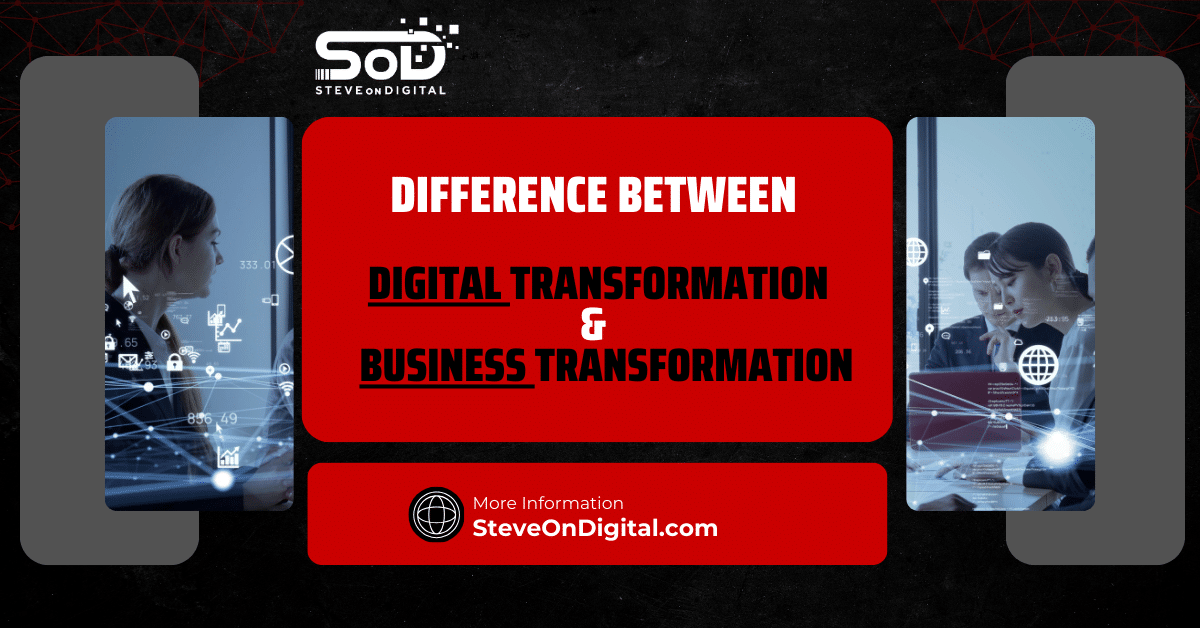Creating an IT roadmap involves planning your technology initiatives to align with your company goals and business objectives. Start by understanding where you are now, set clear strategic objectives, and identify the necessary technology initiatives. Engage key stakeholders for input and develop a visual roadmap to communicate your plans effectively. Regularly update and monitor your roadmap to keep it relevant.
This process helps small businesses manage resources efficiently and achieve strategic goals through technology investments. By following these steps, you can create a comprehensive IT roadmap that guides your business towards success.
I’m Steve, a digital transformation expert with a strong background in electrical engineering, an MBA, and a master’s in Project Management. I excel at helping SMEs navigate the digital landscape with practical insights. Let’s begin!
Understanding IT Roadmaps
Definition Of An IT Roadmap
An IT roadmap is a strategic document that outlines the technology initiatives a business will undertake over a specific period. It serves as a guide for technology infrastructure development, helping businesses align their IT investments with their strategic objectives.
Using a roadmap template can simplify the creation of an IT roadmap by providing a pre-built framework that is easy to update and customize to fit specific needs.
Types Of IT Roadmaps
There are several types of IT roadmaps, each serving a different purpose. The most common types are:
- Technology Roadmap: Focuses on the technology infrastructure and initiatives needed to support business goals.
- Product Roadmap: Details the development and release plans for products and features.
| Type of Roadmap | Focus Area | Description |
|---|---|---|
| Technology Roadmap | Technology Infrastructure | Focuses on the tech infrastructure and initiatives needed to support business goals. |
| Product Roadmap | Product Development | Details the development and release plans for products and features, aligning with business needs. |
Benefits Of Having An IT Roadmap
Having an IT roadmap offers numerous benefits:
- Strategic Alignment: Ensures that your technology initiatives support your business goals.
- Improved Communication: Provides a clear and visual way to communicate your technology plans to stakeholders.
- Better Resource Management: Helps in prioritizing initiatives and allocating resources effectively.
| Benefit | Description |
|---|---|
| Strategic Alignment | Ensures that your technology initiatives are aligned with and support your business goals. |
| Improved Communication | Provides a clear and visual way to communicate your technology plans and progress to stakeholders. |
| Better Resource Management | Helps in prioritizing initiatives and allocating resources effectively to maximize efficiency. |
Additionally, strategic planning is a key benefit of having an IT roadmap, as it helps in creating high-level, visual representations of business initiatives, aligning tech projects with business objectives, and defining long-term plans for reaching goals.
Key Elements Of An IT Roadmap
Strategic Objectives
Setting clear and achievable strategic objectives is the first step in creating an IT roadmap. These goals should match your main business aims and give clear guidance for your technology projects.
- Defining Clear and Achievable Goals: Your goals should be clear, easy to track, realistic, important, and have a deadline. For example, improving customer satisfaction by implementing a new customer relationship management (CRM) system within the next six months. Including a strategic plan in your IT roadmap is crucial as it provides a strategic basis and evidence supporting the plan, effectively communicating it to stakeholders.
Technology Infrastructure
Assessing your current technology infrastructure is crucial to understanding what you have and what you need to achieve your strategic objectives.
- Assessing Current Tech Infrastructure and Future Needs: This involves evaluating your existing hardware, software, and network capabilities. Find any problems or areas that need improvement to help with future technology plans.
Key Stakeholders
Involving key stakeholders and internal teams in the planning process ensures that your IT roadmap addresses the needs and concerns of all relevant parties.
- Identifying and Involving Key Groups in the Planning Process: This includes executives, department heads, and end-users who will be affected by the technology changes. Their input is valuable in creating a roadmap that is practical and aligned with business needs.
| Element | Description |
|---|---|
| Strategic Objectives | Setting clear and achievable strategic objectives that align with business goals. |
| Technology Infrastructure | Assessing current tech infrastructure and identifying future needs to support business goals. |
| Key Stakeholders | Involving executives, department heads, and end-users in the planning process to ensure comprehensive input and buy-in. |
To illustrate, let me share an experience from my own journey. When I was working on a technology roadmap for a client, we started by setting clear strategic objectives. We wanted to enhance their online customer experience by integrating a new e-commerce platform. Assessing their current infrastructure revealed that their existing systems were outdated and couldn’t support the new platform. By involving key stakeholders, including the sales and customer service teams, we were able to identify critical needs and concerns that shaped our roadmap. This collaborative approach ensured that the final roadmap was comprehensive and aligned with the company’s business goals.
Creating an IT roadmap requires careful planning and collaboration, but the benefits are well worth the effort. By defining clear objectives, assessing your technology infrastructure, and involving key stakeholders, you can create a roadmap that guides your business towards its strategic goals.
Steps To Create An IT Roadmap
Creating an IT roadmap is like setting up a detailed plan for a long journey. You need to know where you are starting, where you want to go, and the steps you’ll take to get there.
| Step | Description |
|---|---|
| Assessing Current State | Analyzing existing technology and processes to understand your organization’s current capabilities and limitations. |
| Defining Strategic Objectives | Setting specific, realistic goals for short-term and long-term achievements that align with business objectives. |
| Identifying Technology Initiatives | Planning future tech projects and upgrades to meet strategic goals and improve operational efficiency. |
| Gathering Stakeholder Input | Collecting input from key stakeholders to ensure their perspectives are considered in shaping a practical and aligned roadmap. |
Assessing Current State
Before making any plans, it’s crucial to understand where you currently stand. This involves analyzing your existing technology and processes. When I first started planning for an IT roadmap for a small business client, I conducted a thorough review of their current technology infrastructure.
- Analyzing Existing Technology and Processes: This step involves taking stock of your current tech infrastructure. Evaluate the hardware, software, and network capabilities you have in place. Identify outdated systems and processes that need upgrading or replacement. This helps in understanding what works well and what doesn’t.
Defining Strategic Objectives
Setting clear objectives is like setting destinations on your journey. Without knowing where you want to go, you can’t plan the route effectively.
- Setting Short-term and Long-term Goals: Define what you aim to achieve with your IT roadmap. Your goals should be specific and realistic. For instance, a short-term goal might be upgrading your customer management system within six months, while a long-term goal could involve a complete digital transformation over the next three years.
Identifying Technology Initiatives
Once you have your goals, you need to figure out the steps that will help you reach them. This is where strategic thinking comes into play.
- Planning Future Tech Initiatives to Meet Strategic Goals: Identify the technology projects and upgrades required to meet your strategic objectives. For example, if one of your goals is to improve customer engagement, you might plan to implement a new CRM system or develop a mobile app for better customer interaction. Technology roadmaps play a crucial role in identifying these technology initiatives by aligning tech projects with business objectives and long-term goals.
Gathering Stakeholder Input
Engaging with stakeholders is vital. Their input can provide valuable insights and help in shaping a more effective roadmap.
Importance Of Stakeholder Engagement
I always make it a point to involve key stakeholders early in the process. Their feedback can highlight potential challenges and opportunities that I might overlook.
- Involving Key Stakeholders in the Roadmap Creation: Ensure that you involve executives, department heads, and even end-users in the planning process. Their insights are crucial in creating a roadmap that addresses real needs and gains broad support.
Methods For Collecting Input
To gather stakeholder input effectively, use various methods. Here’s what worked for me:
- Surveys, Interviews, and Workshops: Conduct surveys to gather broad input, hold one-on-one interviews for detailed insights, and organize workshops for collaborative planning. Each method can provide unique perspectives and valuable feedback.
Developing A Visual Roadmap
Creating a visual roadmap makes it easier to communicate your plans and keep everyone aligned.
Creating A Visually Compelling Roadmap
A visually appealing roadmap can serve as a powerful communication tool. It helps in illustrating the steps and timelines clearly.
- Importance of Visual Representation and Tools to Use: Use tools like Gantt charts or roadmap software to create a visual representation of your IT plan. This makes it easier to track progress and communicate updates to stakeholders.
Roadmap Templates And Tools
Using templates and tools can streamline the process of creating a roadmap. I’ve found several tools particularly useful.
- Examples of Effective Roadmap Tools and Templates: Tools like Roadmunk and Aha! offer excellent templates and features that can help you create a comprehensive and visually compelling IT roadmap. These tools provide templates that can be customized to fit your specific needs.
Product managers play a crucial role in selecting the right roadmap tools and templates, ensuring they provide clarity, communication, and alignment with stakeholders.
Creating an IT roadmap involves careful planning and collaboration. By assessing your current state, defining clear objectives, planning technology initiatives, gathering stakeholder input, and developing a visual roadmap, you can ensure that your IT efforts are aligned with your business goals. This process not only helps in achieving strategic objectives but also improves communication and resource management.
Aligning With Business Goals
Aligning your IT roadmap with business goals is crucial for achieving strategic objectives. It ensures that every technology initiative supports the company’s overall vision and direction.
Integrating IT Roadmap With Overall Strategy
When I first started aligning IT initiatives with business goals, I realized the importance of a cohesive strategy. Your IT roadmap should be an extension of your business strategy, not a separate plan.
- Ensuring IT Initiatives Support Business Objectives: Your IT projects should directly contribute to your company’s goals. For example, if your business objective is to improve customer satisfaction, your IT initiatives might include upgrading your CRM system or enhancing your website’s user experience. By aligning IT initiatives with business objectives, you can ensure that technology investments drive business growth.
Setting Realistic Timelines
Setting achievable milestones is like plotting a course on a map. You need clear, realistic timelines to ensure that projects are completed on schedule and resources are effectively utilized.
- Importance of Setting Achievable Milestones: Break down large projects into smaller, manageable phases with specific deadlines. This approach helps in tracking progress and making necessary adjustments along the way. For instance, when I implemented a new ERP system, we set quarterly milestones to monitor progress and address any issues promptly. This phased approach kept the project on track and ensured timely completion.
Involving Cross-Functional Teams
Collaboration across different departments is essential for the successful implementation of an IT roadmap. Each team brings unique insights and expertise, contributing to a more comprehensive plan.
Role Of Cross-Functional Teams
Cross-functional teams are like different parts of an engine, each playing a vital role in making the machine run smoothly.
- Importance of Collaboration Across Departments: Involving various departments, such as finance, marketing, and operations, ensures that the IT roadmap addresses diverse needs and perspectives. For example, when planning a new e-commerce platform, input from the sales and customer service teams can help design features that enhance customer experience and streamline sales processes.
Communication Strategies
Effective communication is key to ensuring that all teams understand and support the IT roadmap.
- Ensuring All Teams are on the Same Page: Use regular meetings, updates, and collaborative tools to keep everyone informed. Tools like Slack or Microsoft Teams can facilitate real-time communication and collaboration. When I was working on a digital transformation project, we held weekly updates to discuss progress and address any concerns. This open communication ensured that everyone was aligned and working towards the same goals.
Managing The Development Process
Effective project management is critical for the successful execution of an IT roadmap. It involves planning, organizing, and overseeing the project to achieve the desired outcomes.
Project Management Best Practices
Implementing best practices in project management can significantly improve the chances of success.
- Techniques for Effective Project Management: Use project management methodologies like Agile or Scrum to manage the development process. These frameworks promote flexibility and continuous improvement, allowing teams to adapt to changes quickly. For instance, in my experience, using Agile for software development projects enabled us to deliver incremental updates and respond to user feedback promptly.
Handling Complex Projects
Managing multiple products and initiatives can be challenging, but with the right strategies, it can be done efficiently.
- Strategies for Managing Multiple Products and Initiatives: Prioritize projects based on their impact on business objectives and allocate resources accordingly. Use project management tools like Jira or Asana to track progress and manage tasks. When handling complex projects, it’s crucial to maintain a central location for all project information. This ensures that everyone has access to the latest updates and can collaborate effectively.
Aligning your IT roadmap with business goals, involving cross-functional teams, and managing the development process effectively are essential steps in creating a successful IT roadmap. By integrating your IT initiatives with your overall strategy, setting realistic timelines, fostering collaboration, and implementing best practices in project management, you can ensure that your IT roadmap drives business growth and achieves strategic objectives.
Monitoring And Updating The Roadmap
Creating an IT roadmap is not a one-time task. It’s a dynamic process that requires continuous monitoring and updating. This ensures that the roadmap stays relevant and effective in achieving your business goals.
Continuous Improvement
In my experience, regular updates and revisions are essential for maintaining an effective IT roadmap.
- Importance of Regular Updates and Revisions: Technology and business environments change rapidly. Regularly reviewing and updating your IT roadmap helps you adapt to new opportunities and challenges. For example, when a new technology emerges that could benefit your business, updating your roadmap allows you to integrate it seamlessly into your existing plans.
Tracking Progress And Adjusting Plans
Monitoring progress is like keeping an eye on your speedometer during a road trip. It helps you stay on track and make necessary adjustments.
- Methods for Monitoring Overall Progress: Use project management tools to track the progress of your technology initiatives. Tools like Jira or Trello can help you monitor tasks and deadlines. Regular check-ins and progress reviews ensure that your team is on the same page and that any issues are addressed promptly. When I was leading a digital transformation project, we held bi-weekly reviews to track our progress and adjust our plans as needed. This proactive approach kept us on track and ensured timely project completion.
Utilizing Roadmap Examples
Learning from successful roadmaps can provide valuable insights and inspiration for your own planning.
Learning From Successful Roadmaps
Case studies and good examples can serve as a guide and benchmark for your IT roadmap.
- Case Studies and Good Examples: Look at case studies of companies that have successfully implemented IT roadmaps. Analyze what worked for them and how they overcame challenges. For instance, a company might have streamlined its technology initiatives by prioritizing customer-centric projects, leading to increased customer satisfaction and revenue growth. These examples can provide practical insights and best practices that you can apply to your own roadmap.
Customizing Templates
Adapting existing templates to fit your specific needs can save time and provide a structured approach to creating your roadmap.
- Adapting Existing Templates to Fit Specific Needs: Use templates from roadmap tools and customize them to suit your business requirements. For example, tools like Roadmunk or Aha! offer customizable templates that can be tailored to your strategic objectives and technology initiatives. Customizing these templates ensures that your roadmap addresses your unique business needs and goals.
Tools For Roadmap Creation
Using the right tools can simplify the process of creating and managing your IT roadmap.
| Tool | Features |
|---|---|
| Roadmunk | Provides templates and visual representations for creating comprehensive roadmaps. |
| Aha! | Offers customizable templates to fit specific strategic objectives and technology initiatives. |
| Jira | Facilitates project tracking, progress monitoring, and task management for IT initiatives. |
Roadmap Apps And Software
There are various apps and software available that can help you create a detailed and effective IT roadmap.
- Overview of Popular Tools: Tools like Roadmunk, Aha!, and Jira offer features that facilitate roadmap creation and management. These tools provide visual representations of your roadmap, making it easier to communicate your plans to stakeholders. In my projects, I’ve found Roadmunk particularly useful for its intuitive interface and powerful features.
Features To Look For
When choosing a roadmap tool, look for features that will help you create a comprehensive and actionable roadmap.
- Key Elements of Effective Roadmap Tools: The best roadmap tools offer features like drag-and-drop functionality, timeline views, and collaboration capabilities. Look for tools that allow you to create a visually compelling roadmap, set realistic timelines, and track overall progress. Features like these make it easier to manage complex projects and ensure that your roadmap is aligned with your business goals.
Final Thoughts
Creating an IT roadmap is a strategic process that requires careful planning, collaboration, and continuous improvement.
Recap Of Key Points
To summarize, here’s a quick recap of the roadmap creation process:
- Assess your current technology infrastructure and processes.
- Define clear strategic objectives and set achievable goals.
- Identify technology initiatives that support your business objectives.
- Involve key stakeholders and gather their input.
- Develop a visual roadmap using effective tools and templates.
- Continuously monitor and update your roadmap to keep it relevant.
Importance Of A Well-Defined IT Roadmap
A well-defined IT roadmap is crucial for aligning your technology initiatives with your business goals. It provides a clear direction for your technology strategy, improves communication with stakeholders, and helps in managing resources effectively. By following the steps outlined in this guide, you can create a comprehensive IT roadmap that drives business growth and achieves your strategic objectives.
In conclusion, creating an IT roadmap is a dynamic and ongoing process. Regular updates, stakeholder engagement, and effective project management are key to its success. With a well-defined roadmap, you can navigate the complexities of technology planning and ensure that your IT initiatives are aligned with your business goals.




